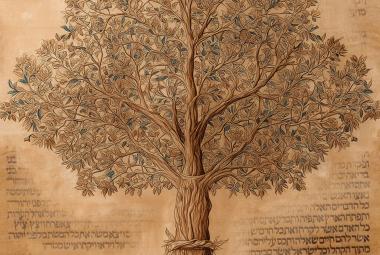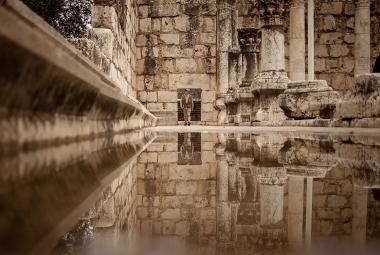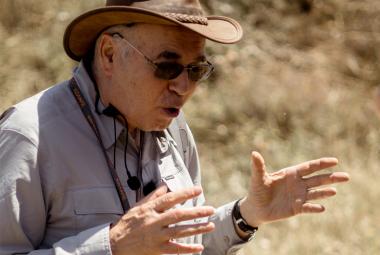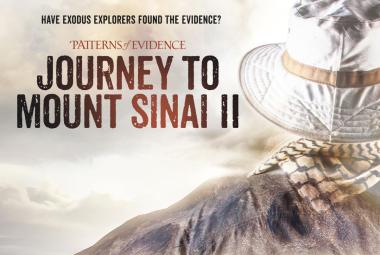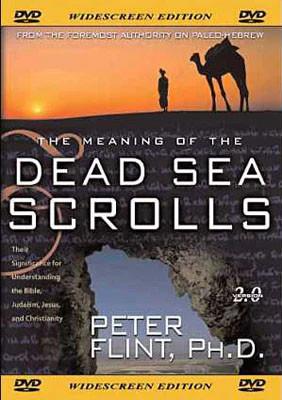In 1948, famed archaeologist and leading Biblical scholar William Albright made the extraordinary claim that the Dead Sea Scrolls were “the greatest archaeological find of the 20th century.”
This amazing discovery was made in 1947 by Bedouin shepherds in a cave near Khirbet Qumran, about one mile inland from the western shore of the Dead Sea. By 1956, a total of eleven caves had been found at Qumran.
The caves yielded various artifacts, especially pottery. The most important find was scrolls written in Hebrew, Aramaic, and Greek, the three languages of the Bible. Almost 900 were found in the Qumran caves in about 25,000-50,000 pieces. While a few scrolls are well-preserved, almost all are damaged and most are very fragmentary.
The earliest scrolls found at Qumran date from about 250 B.C. or a little earlier; the latest were copied shortly before the destruction of the Qumran site by the Romans in 68 A.D. Further scrolls were discovered at other locations in the vicinity of the Dead Sea, especially Wadi Murabba‘ât (1951-52), Nahal Hever (1951-61), and Masada (1963-65).
Scholars divide the 950 or so scrolls found in the Judean desert into two general categories of writings: the “Biblical” scrolls, which constitute our earliest witnesses to the text of Scripture, and the “Non-Biblical” scrolls, which anticipate or confirm numerous ideas and teachings found in the New Testament and in later Rabbinic writings (the Mishnah and Talmud).
With respect to the 230 or so Biblical Scrolls (about 25% of the total), there are four reasons for Albright’s claim that the scrolls are the greatest archaeological find of the 20th century:
1) The Scrolls were Found in the Land of Israel Itself.
Prior to the discovery of the Dead Sea Scrolls, virtually no writings dated to the Second Temple Period (that is, when the Temple stood from 516 B.C. to 70 A.D.) had been found in Israel. Now we have hundreds of documents from the time of Jesus and earlier that were written or produced near Jerusalem and other Biblical sites.
2) The Scrolls are Written in the Three Languages of Scripture.
For Biblical scholars, the most important manuscripts are written in the original Hebrew, Aramaic and Greek. The Scrolls include ancient Biblical manuscripts in Hebrew and Aramaic (portions of Daniel), and parts of the Septuagint in the original Greek.
3) The Scrolls Include Our Oldest Biblical Manuscripts.
The antiquity of the Biblical Scrolls is of supreme importance for Biblical scholars. Virtually all copies of the Hebrew Bible used today are based on medieval manuscripts; the oldest Hebrew manuscript fragment known before the discovery of the scrolls was the Nash Papyrus, which is dated at 150-100 B.C.
In contrast, all the scrolls found at Qumran are dated within the Second Temple Period, from 250 B.C. or a little earlier to just before the destruction of the Qumran site in 68 A.D.
4) Some Biblical Scrolls Preserve Lost Readings with Messianic Implications.
One example is at Psalm 22:16. This Psalm (which begins with “My God, my God, why have you forsaken me?”) is significant in both Jewish and Christian exegesis, and is quoted several times by Jesus in relation to his sufferings and death. A difficult reading is found in verse 16 (Hebrew v. 17) of the traditional Masoretic text, which reads “For dogs have surrounded me: the assembly of the wicked have encompassed me: like a lion are my hands and my feet.” The King James Bible, following the Septuagint (Greek Old Testament) reads “They have pierced my hands and feet.”
It has been suggested that the Septuagint reading here represents a modification of the Hebrew “like a lion” in order to make better sense of the verse, or that early Christian editors changed the Greek text in order to find evidence for Jesus’ crucifixion in the Hebrew Bible.
The passage is preserved in the Psalms scroll from Nahal Hever, which reads “They have pierced my hands and feet.” Also supported by the Septuagint and a few Masoretic manuscripts from the Middle Ages, this reading has been adopted by many modern English Bibles, including the Revised Standard Version, the New Revised Standard Version, the New American Bible, the New American Standard Bible, the New International Version, the English Standard Version, and the Holman Christian Bible.
The 650 or so Non-Biblical Scrolls contain a wealth of writings, most of them previously unknown to scholars. These can be divided into are five categories: Rules and Regulations (e.g., the Community Rule); Poetic and Wisdom Texts (e.g., the Thanksgiving Psalms); Reworked or Rewritten Scripture (e.g., the Genesis Apocryphon); Commentaries or Pesharim (e.g., the Commentary on Habakkuk); and Miscellaneous Writings (e.g., the Copper Scroll).
These documents provide two additional reasons why the Dead Sea Scrolls comprise the greatest archaeological find of our times:
5) They Contain New Information on Second Temple Judaism.
Several non-Biblical Scrolls record the ideas and outlook of the Qumran Community, whom most scholars identify with the Essenes. We already knew a good deal about the Pharisees and the Sadducees, the two main Jewish groups in the days of Jesus Christ. Some scrolls provide further information on these groups, but also contain fascinating insights on the intense competition among various Jewish groups in ancient times to be the legitimate and chosen people of God.
One such document, from Cave 4 at Qumran, is called Some of the Works of the Law, in which the Essenes or their predecessors spell out the rules and observances that make a person acceptable in the sight of God, in contrast to the incorrect observances promoted by their opponents, the Pharisees.
6) New Information on the New Testament and Christian Origins.
The scrolls were not written by Christian authors and never mention any Christian individuals by name, and thus have no direct relationship with Jesus and early Christianity. However, some manuscripts are important for understanding Jesus’ life and teaching, while others anticipate several New Testament doctrines. More specifically, these ancient documents throw welcome light on the Gospels by:
- Providing helpful information about Jewish society, groups, practices, and beliefs at the time of Jesus and the early Christians.
- Increasing our knowledge about Early Judaism, which makes it clear that many aspects of the Gospel message are indebted to the mother religion.
- Helping us see in sharper outline some of the basic differences between the message of Jesus and other Jewish groups.
- Providing new texts with similarities to certain Gospel passages, which indicates that some of Jesus’ teaching and other information was anticipated in earlier texts, rather than being the product of the later Church. A few documents, in fact, contain wording that is very close or identical to passages found in the Gospels, which shows that this material was known to some or many Jews in the first century B.C., and thus confirms the authenticity of certain New Testament passages.
One example is the Son of God Text or Apocryphon of Daniel (4Q246). Written in Aramaic and copied in the late first century B.C., this scroll apparently describes a messianic figure at the end times (although some scholars see him as an historical king or angelic figure). There are interesting parallels with the Annunciation of Jesus’ birth to Mary in Luke 1:30-35: the coming figure “will be called great” (cf. col. 1:9 with Luke 1:32); “‘Son of God’ he shall be called” (cf. col. 2:1 with Luke 1:35); and “they will name him ‘Son of the Most High’” (cf. col. 2:1 with Luke 1:32). It thus seems reasonable to see connections, whether direct or indirect, between the Son of God Text and passages in Luke.
For more information on this fascinating topic, see Dr. Peter Flint’s DVD, The Meaning of the Dead Sea Scrolls.

